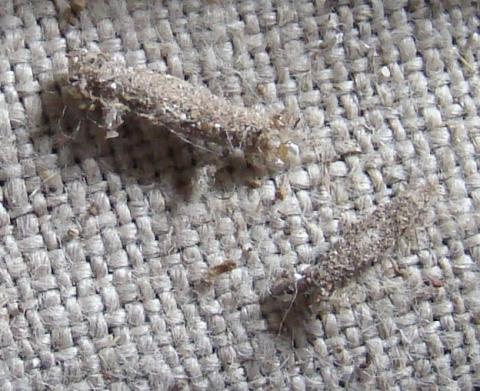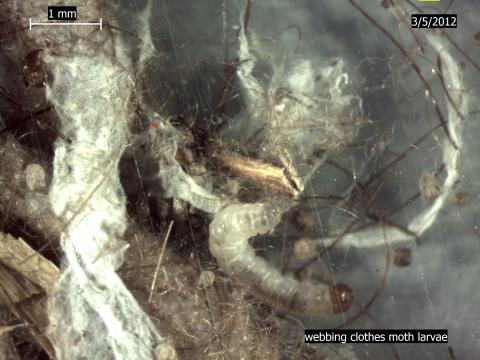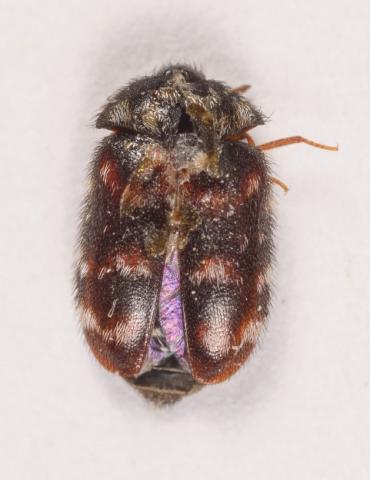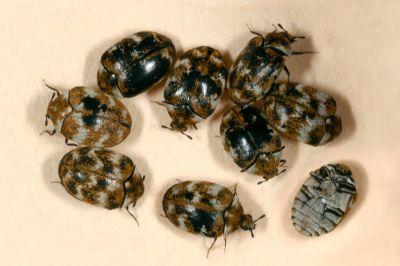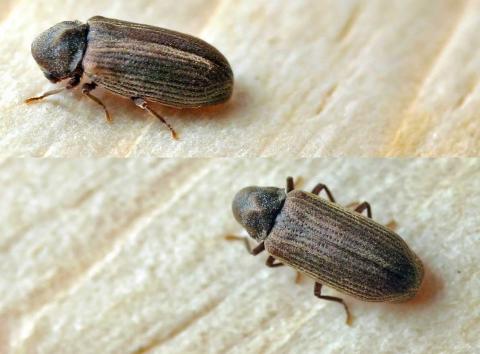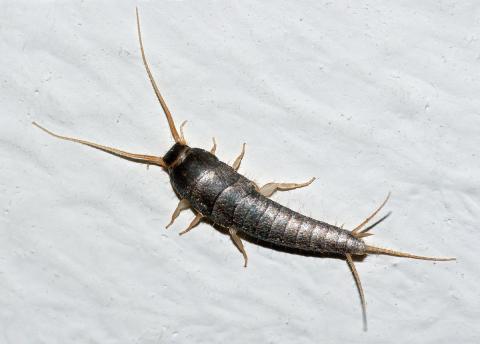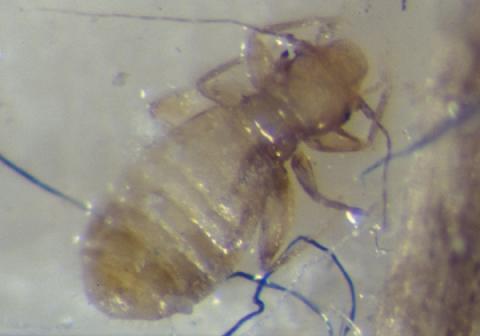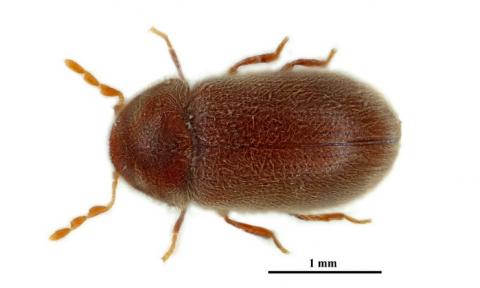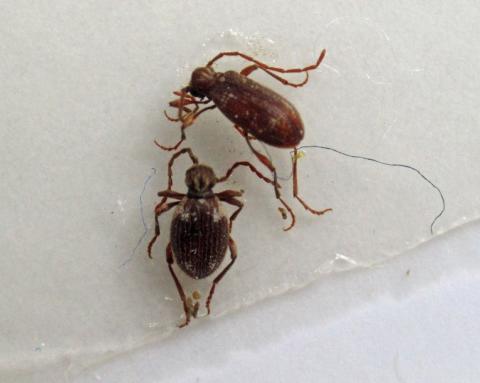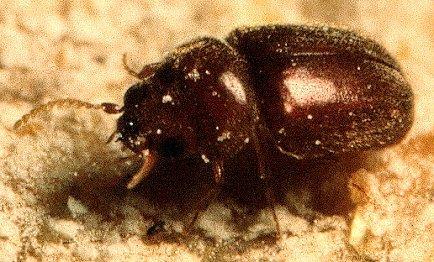Appendices
Appendix 1: Measuring Light Levels with a Camera
Equipment Required
- 35 millimetre camera with a built-in light meter; and
- white cardboard (about 30 - 40 square centimetres).
Method
- place the cardboard in the same position and at the same angle as the object or area that is being measured;
- set the camera to 800 ASA and without casting a shadow on the white cardboard, take an f-stop and shutter speed reading with the camera;
- the cardboard should fill the frame in the viewfinder of the camera; and
- use the coordinates obtained to determine the light level using the table shown below (for example, f8 at 1/30 sec = 700 lux).
| Lux | 88 | 175 | 350 | 700 | 1400 | 2800 | 5500 | |
| F-stop | 2.8 | 1/30 | 1/60 | 1/125 | 1/250 | 1/500 | 1/1000 | 1/2000 |
| 4 | 1/15 | 1/30 | 1/60 | 1/125 | 1/250 | 1/500 | 1/1000 | |
| 5.6 | 1/8 | 1/15 | 1/30 | 1/60 | 1/125 | 1/250 | 1/500 | |
| 8 | 1/4 | 1/8 | 1/15 | 1/30 | 1/60 | 1/125 | 1/250 | |
| 11 | 1/2 | 1/4 | 1/8 | 1/15 | 1/30 | 1/60 | 1/125 | |
| 16 | 1 | 1/2 | 1/4 | 1/8 | 1/15 | 1/30 | 1/60 | |
| 22 | 2 | 1 | 1/2 | 1/4 | 1/8 | 1/15 | 1/30 | |
| 32 | 4 | 2 | 1 | 1/2 | 1/4 | 1/8 | 1/15 | |
| Shutter speed in seconds | ||||||||
The values quoted in the table were obtained using a Gossen Lunasix 3 light meter, cross referenced with a range of Nikon cameras. Regard the readings as approximations only.
Appendix 2: Environmental Criteria for Materials
The information in this appendix was compiled from ‘Museum Methods: Practical Manual for Managing Small Museums’, Section 3 Preventive Conservation (Museums Australia Inc. NSW 1994) and adapted to accommodate recent changes in environmental guidelines for particular material types.
Minimal relative humidity (RH) fluctuations are essential to prevent damage to susceptible materials. Well sealed display cases give additional buffering to environmental changes and pollution ingress. Very sensitive and sensitive materials should be rotated on and off display as indicated.
| Environment | Materials | Special conditions |
|---|---|---|
| Very Sensitive Materials | ||
| Display: Temperature 15 - 25°C Relative humidity 45 - 55% Max lux 50 UV less than 30 µw/lumen Display period 3 mths per 12 mths Storage: Same Temp and RH Eliminate light |
Baleen |
|
| Cardboard | ||
| Drawing – charcoal, crayon, gouache, ink | ||
| Feathers | ||
| Fur, hair | ||
| Lacquer (oriental) | RH critical | |
| Leather dyed | ||
| Nylon | RH 60 % preferred | |
| Paper, works on paper | RH critical | |
| Parchment | RH ~ 55% preferred and Temp sensitive | |
| Pastel | Fragile surface | |
| Photographs | 16 - 20 °C, RH 30 – 40% | |
| Plant material, seaweed | ||
| Tapa | RH critical | |
| Textiles, including hemp | Dust free | |
| Water colours | ||
| Sensitive Materials | ||
| Display: Temperature 15 - 25°C Relative humidity 40 - 60% Max lux 200 Max UV 75 µw/lumen Display period 6 mths per 12 mths Storage: Same Temp and RH Eliminate light |
Bakelite, casein | Casein – RH 60 % preferred |
| Bitumen | Dust free | |
| Bone | RH critical (45 – 55%) | |
| Canvas | Dust free | |
| Composite frame mouldings | ||
| Coral | Acid sensitive | |
| Cork | ||
| Fibreglass | ||
| Gesso | Acid sensitive | |
| Horn | RH critical (45 – 55%) | |
| Ivory | RH critical (45 – 55%) | |
| Leather - undyed, tawed | Some sulphur sensitive, RH 45 – 65% | |
| Linoleum | ||
| Paint, protective coating | ||
| Paintings, oil, tempera, acrylic | RH critical (45 – 55%) | |
| Shell, mother-of-pearl, pearl | Acid sensitive | |
| Shellac | Temp. sensitive | |
| Tortoiseshell | RH critical (45 – 55%) | |
| Wax | Temp & solvent sensitive, dust free | |
| Wood, bamboo, cane, straw, wicker | RH critical | |
| Non-sensitive Materials | ||
| Display: Temperature 15 - 25°C Relative humidity 30 - 60% Max lux 300 Max UV 150 µw/lumen Display period unrestricted Storage: Same Temp and RH Eliminate light |
Aluminium | Acid and alkali sensitive |
| Amber | Solvent sensitive | |
| Brick | ||
| Ceramics, porcelain | 40 – 60% RH | |
| Copper, bronze, brass | Less than 45% RH | |
| Enamel | Temp sensitive | |
| Glass | 40 – 60% RH | |
| Gold | ||
| Iron, iron alloys | Less than 35%RH | |
| Lead | Less than 45%RH, organic acid and formaldehyde sensitive | |
| Marble, some sandstone | Acid sensitive | |
| Plaster | Acid sensitive | |
| Silver | Less than 45%RH, sulphur sensitive | |
| Stone | Less than 20 °C, RH 45 – 55 % | |
| Tin/tin plate | Less than 45%RH | |
| Plastics | ||
| Display: Temperature as low as practical Relative humidity less than 50% Max lux 50 Max UV 30 µw/lumen Display period 3 mths per 12 mths Storage for most plastics: Temperature 2 - 5°C Relative humidity less than 50% Eliminate light Reduced oxygen environment |
Acrylic plastics e.g. perspex | Solvent sensitive, display period 9 mths per 12 mths |
| Magnetic tape (audio/video) | Use copy, cool store original | |
| Micro forms (fiche/films) | Use copy, cool store original | |
| Plastics | Cool, oxygen free best, off gas pollutants | |
| Rubber | Cool, oxygen free best, off gas pollutants | |
Appendix 3: Chemical Treatments of Insects
The information contained in this appendix is based on a Technical Bulletin prepared by Dawson (1992).
Only a few representative chemicals are included in this appendix. Inclusion is not a recommendation for use, with a few commonly used pesticides included to alert readers to some of the potentially damaging effects of these products. Use this information as a guide when considering what action to take in response to insect attack on collections. Always remember to consult a conservator if in doubt about the impact of a particular treatment on objects in a collection. Also check with local authorities regarding the application of any large scale pest treatment to ensure compliance with regulations and laws regarding the use of potentially toxic chemicals.
Fumigants
As long as the concentration and exposure times are appropriate, fumigants should be effective against all stages of insect development, from the egg to the adult. Fumigation does not however, provide any long-term protection. Treated artefacts must be well aired before they are removed from the fumigation chamber. The duration of airing will depend on the type of fumigant used.
Common fumigants include:
Dichlorvos (DDVP, Dichlorfos, Vapona)
- is the active ingredient in resin pest strips;
- is useful in storage environments and against general household pests;
- lacks penetration and is ineffective against insect eggs;
- reacts with alkaline materials;
- has been found to discolour some textiles, is corrosive to mild steel and black iron and can tarnish copper, silver and brass. It deposits a film on zinc, tin and lead;
- may damage artefacts if they come into contact with them;
- should be handled carefully as it is toxic to humans (acute oral LD50 of 56-80mg/kg for rats) and is absorbed easily through the skin; and
- is not recommended for use in museum collections.
Ethylene Oxide
- has been widely used in the past, but its use is no longer recommended for the treatment of museum objects;
- is effective against major infestations, but is problematic due to its long retention by some materials and its reactions with some material types; and
- is a carcinogen and known to cause mutations.
Methyl Bromide
- is used to fumigate stored materials and soils;
- reacts with materials which contain sulphur;
- should not be used with woollens, viscose, rayons, vinyl, paper (sulphide process), rubber, furs, horse hair, feathers, leather goods and photographic chemicals;
- has no effect on oil paintings on canvas but some powdered pigments are affected;
- is very toxic to humans and is a potential carcinogen; and
- should only be used if there is a major infestation and if there are no other methods available.
Naphthalene (Mothballs, White Tar)
- is used as a fumigant and a repellent for general and domestic purposes;
- is only effective if used in well-sealed containers with exposure times of two to six weeks at ambient conditions;
- is considered non-corrosive and non-staining but has discoloured wool and may dissolve fats in biological specimens;
- should not come into direct contact with artefacts because it may damage them; and
- is a risk to the health of users as it is a skin irritant and inhalation of vapour is known to cause nausea, headaches and acute haemolytic anaemia.
Paradichlorobenzene
- is used as a fumigant and repellent for general and domestic purposes;
- is more volatile than naphthalene and is generally more effective - two weeks at room conditions is sufficient to kill the common clothes moth;
- can affect zinc white, lithopone, scarlet pigments, some cellulose acetate dyes, polystyrene foams, styrene and cellulose nitrate plastics, paper and ink; and
- is a health risk to users via inhalation, ingestion or eye and skin contact. Signs and symptoms of poisoning include vomiting, headaches, liver cirrhosis and kidney damage.
Organochlorine Insecticides
Insecticides in this group include aldrin, chlordane, dieldrin, lindane and pentachlorophenol. Due to their damaging effects on artefacts and health considerations they should not be used on museum artefacts or in buildings which contain collections.
Organophosphorous Insecticides
These compounds are generally more toxic than the organochlorine group but are usually applied at much lower concentrations, reducing the health risks slightly.
Chlorpyrifos
- is used as a contact insecticide and may be applied in a variety of forms (solution, granules, spray);
- has a residual action of about thirty days indoors but has poor knockdown and flushing capabilities. It can persist on wood for several years and has a longer residual action on non-porous materials than most insecticides;
- may affect nearby artefacts if they are not covered during its application;
- is corrosive to copper and brass and produces colour changes in some red dyes (acid red and disperse dyes); and
- is moderately toxic to humans via skin absorption, inhalation of dusts and ingestion. Symptoms may be mild (nausea and dizziness) or severe in extreme cases (fever, coma and respiratory failure).
Diazinon
- is used as a contact insecticide and is available in a variety of forms;
- has a residual activity of about 30 days indoors with a longer life on porous surfaces;
- is moderately to very toxic to fish, birds and bees;
- causes slight to very slight colour changes in acid red and disperse red dyes;
- may affect uncovered artefacts near the application site; and
- is a health risk to users in a similar fashion to that described for chlorpyrifos.
Malathion
- is a contact insecticide formulated as a wettable powder, a dust or an emulsifiable concentrate;
- is corrosive to iron, steel, tin plate and copper and produces unacceptable colour changes in acid red and disperse red dyes. As malathion’s effects on other materials are unknown caution is advised in its use; and
- is considered to be the least toxic of the organophosphorous insecticides but is highly toxic if ingested and may cause foetal abnormalities. Care must be taken when using it.
Carbamates
These materials are less volatile than organophosphates and consequently pose less of a risk of vapour poisoning.
Bendiocarb (Ficam)
- is a contact insecticide formulated as a dust or wettable powder. It has no fumigant properties;
- has a residual activity for weeks or months, depending on the environmental conditions;
- has no effects on acid red, telon red or disperse red dyes as it is applied as a powder; and
- poses some risk to health via inhalation, skin or eye contact or ingestion, though this is less so than with materials which possess higher vapour pressures.
Carbaryl (Sevin)
- is a contact insecticide available in a variety of formulations;
- has a moderate residual action depending on conditions (three to four days to several months);
- is non-corrosive but solvent effects may occur if it is allowed to contact artefacts;
- should not be allowed to come into contact with artefacts due to its residual activity; and
- is moderately toxic to people via inhalation, skin or eye contact or ingestion, toxic to bees, is a carcinogen (in rats), has caused genetic mutations in experiments and foetal abnormalities in many animals.
Propoxur (Baygon)
- is an emulsifiable concentrate which is also available as a pressurised spray and solution;
- has a good flushing action, rapid knockdown and a residual activity indoors of up to forty-five days;
- appears to have little effect on materials, though excessive wetting of plastics, rubber, asphalt and floor coverings should be avoided. Do not use on any materials prone to staining (carpets, curtains, wallpaper and the like). Avoid direct contact with artefacts; and
- is moderately toxic to humans via inhalation, skin or eye contact or skin absorption. It is also toxic to birds, fish and other wildlife.
Botanicals
Botanical insecticides are those derived from plants. The pyrethrin class is the most significant of the botanical insecticides. Commercially available synthetic pyrethrins (pyrethroids) have a greater residual activity and higher toxicity than their naturally occurring counterparts.
Pyrethrins
- act as contact insecticides and are available as pressurised sprays, dusts and oil solutions;
- are unstable and breakdown quickly to produce non-toxic residues;
- have rapid knockdown and flushing capabilities but do not always kill all of the insects knocked down;
- are often combined with other chemicals to increase their effectiveness;
- should not be allowed to come into direct contact with artefacts; and
- are of little danger to mammals but are toxic to fish.
Inorganics
Boric Acid
- is a stomach poison that is effective against crawling insects. It is relatively slow acting, taking from two to ten days to kill;
- can remain active for up to twelve months if applied in clean, dry areas;
- should not be applied directly to artefacts or be placed in areas where it will be contacted as no specific information is available regarding its reactivity with materials;
- should be handled carefully despite the relatively low risk of poisoning associated with its use; and
- has been used extensively in natural history collections as a substitute for arsenic.
Diatomaceous Earth
- is a desiccant insecticide often used in combination with pyrethrins;
- should not be allowed to come into direct contact with artefacts or be placed in areas where it is likely to be contacted as there is no specific information available regarding its reactivity;
- extends the persistence of pyrethrins when these compounds are combined; and
- can be forced into cracks and crevices where liquids would not be effective.
Bibliography
Dawson, J. E. (revised by T. J. K. Strang), 1992, Solving museum insect problems: Chemical control, Technical Bulletin No. 15, Canadian Conservation Institute, Otttawa, pp. 1-26.
Appendix 4: Insect Pests
The summary below of common insect pests is based on information provided in a previous Western Australian Museum publication (1981).
Case-bearing or Case-making Clothes Moth
Figure 1: Cocoons of the case-bearing clothes moth (image courtesy museumpests.net).
- Webbing clothes moth (Tinea biselliella – Figure 2):the moth lays 100 or more very small eggs on almost any fabric or material of animal origin (wool, feathers, fur, hair, skin) particularly if dusty or dirty; • the eggs hatch in about one week and the tiny caterpillars (larvae) do the damage while feeding;
- the larvae are creamy-white with dark heads and are about 12.5 mm long when fully grown;
- the larvae spin cocoons and carry them with them throughout their lives, enlarging the cocoons as necessary; and • when ready to emerge from their cases as moths, the larvae often stray away from their food so that small woven cases containing pupae may occasionally be found suspended from the bare walls or ceiling of a room.
Figure 2: Larva of the webbing clothes moth (image courtesy museumpests.net).
- the larvae of the webbing clothes moth spins a loose silken web or tunnel on the surface of its food material. Dusty or dirty material is preferred;
- the larval stage may last several months or even years;
- when the larva is ready to emerge a silken cocoon is formed, into which small pieces of wood, grass and similar materials are incorporated; and
- the adult emerges after two to five weeks, after which it spends a brief time mating and laying eggs.
Hide Beetle (Family Dermestidae)
Figure 3: Hide beetle (image courtesy museumpests.net).
- the adult beetle is a small ovoid, dark-coloured insect, often with patterns of coloured scales or hairs;
- it is usually found on flowers in the garden;
- the larvae are oval with distinct segments and the body is densely covered with long hairs, some of which may be spear-headed or clubbed;
- the larvae feed on dry animal material of high protein content such as skins, hides, furs, leather and textiles as well as foodstuffs (bacon, cheese); and
- when about to emerge, the larvae leave their food supply and burrow into and consequently damage neighbouring material. The adults, about 6 to 10 mm in length, are often found in materials on which they cannot feed.
Carpet Beetle (Anthrenus sp)
Figure 4: Carpet beetle
(a) Adult carpet beetles.
(b) Carpet beetle larvae.
(image courtesy museumpests.net)
- one of the most common carpet beetles is Anthrenus australid, the Australian carpet beetle;
- the beetle is a small round 3 mm long insect, dark in colour with four distinct wavy white bands across its back, giving it a mottled appearance;
- although commonly found in flower beds, the adult lays its eggs indoors, preferably on materials such as wool, feathers, silk or fur. These serve as a food supply for the larvae;
- the eggs hatch after about 14 days and the larvae may be active for several months depending on temperature and humidity; and
- as they grow the larvae shed their skins. The empty hairy skins are one of the characteristic signs of this insect.
Furniture Beetle (Anobium sp)
Figure 5: Furniture beetle.(By ©entomart, Attribution, https://commons.wikimedia.org/w/index.php?curid=438007).
- the adult beetle lays white, lemon-shaped eggs in cracks and crevices of wooden furniture and timber, particularly in the end grain;
- the eggs hatch in about four to five weeks and the grub then bores into the timber;
- the larvae attack pine, Australian cedar, European oak, beech and elm but not eucalypts;
- when fully grown the larva is about 5 mm long, has dark brown jaws and is covered with short, yellowish hair;
- damage is caused by the burrowing larvae tunnelling into the timber and using the bore dust or ‘frass’ to pack the tunnel behind it;
- the frass may be used as a diagnostic aid with that being produced by Anobium being abundant, loose, gritty and not unlike fine table salt;
- on reaching maturity the larva excavates a small chamber near the wood surface, changes into a pupa and then, in six to eight weeks, into an adult. The adult then bores its way out, leaving an exit hole about 1.5 mm in diameter, to fly away and wreak havoc elsewhere; and
- factors which favour furniture beetle attack are high moisture content, warm environment, wide sapwood, low resin content and the presence of fungal decay in the wood.
Silverfish (Family Lepismatidae)
Figure 6: Silverfish.
(By Christian Fischer, CC BY-SA 3.0, https://commons.wikimedia.org/w/index.php?curid=28984904).
- the silverfish is the most common pest found in paper and textile collections;
- it is rarely seen because of its preference for dark, quiet, humid and secluded places;
- the insect is silvery-grey in colour and when mature is about 15 mm in length;
- the insects emerge from the eggs as miniature adults and grow through a series of moults;
- the life span of this insect can be up to four years. The eggs hatch in ten to sixty days and sexual maturity is reached in two to three months;
- of most concern to collectors are those silverfish which feed on cellulosic materials such as paper, sizing, glue, cotton materials and rotting wood. If unchecked these species can seriously damage books, drawings, prints and cotton fabrics; and
- if a silverfish is detected, inspection of the whole collection and appropriate treatment is needed.
Book Lice (Order Psocoptera)
Figure 7: Adult booklouse (image courtesy museumpests.net).
- are not true lice and are very small (1 – 2 mm in length) with a ‘slightly transparent’ brown colour. The adults do not have wings;
- the young (nymphs) hatch from eggs and look like miniature adults when born
- prefer warm, high humidity environments (conducive to mould growth) in quiet, undisturbed places like under books and paper, in furniture and along the sides of windows;
- feed on microscopic moulds on the surface of paper-based materials, glues, binders and paper sizing and any mouldy plant-based material; and
- damage caused by book lice is similar to that caused by silverfish.
Biscuit or Drugstore Beetle (Stegobium paniceum)
Figure 8: Adult biscuit beetle (image courtesy museumpests.net).
- is a very small brown beetle that is in the same family as the wood-boring beetles (see Furniture beetle above) and is commonly found in old bird nests;
- is similar in appearance to the cigarette beetle but is slightly larger (about 3.5 mm long) and is distinguished by its characteristic antennae, each of end in 3-segmented ‘clubs’;
- the white larvae are very small but active when they hatch, feeding and growing for about 2 months;
- feeds on dried plant matter such as tobacco, nuts and dried plant samples. They may also feed on high starch paper objects (e.g. papier-mache) and dried animal specimens;
- the larvae pupate inside cocoons, often within their food source, before emerging via holes that resemble typical wood-boring exit holes; and
- is capable of causing considerable damage in susceptible materials.
Spider Beetle (Ptinus tectus)
Figure 9: Spider beetle (image courtesy museumpests.net).
- is a small brown insect covered with short hairs;
- larvae are large (5 - 7 mm), yellowish-white with a brown head and a ‘curled’ body covered with fine hairs. The adults are relatively small (2.5 – 4 mm long), slow moving, nocturnal and with a slight resemblance to spiders;
- larvae feed on general debris including other dead insects, boring holes into their food sources. They will infest all types of dry animal and vegetable matter;
- cause damage when the larvae bore holes in which to pupate as well as by contaminating objects with faeces and silk webbing. Adults will also damage packaging such as bags and sacks.
Cigarette Beetle (Lasioderma serricorne)
Figure 10: Cigarette beetle.
(By Andybrookestar (talk) (Uploads) - Own work, Public Domain, https://en.wikipedia.org/w/index.php?curid=9674070).
- the adult is yellowish to reddish brown in colour, about 2.5 mm long and similar in appearance to the biscuit and the common furniture beetle;
- larvae are creamy-white in colour with a worm-like shape. They feed on dried and processed foods, tobacco (obviously!), book bindings and dried plant material; and
- they prefer warm (> 20 °C) dark areas.
Bibliography
Department of Materials Conservation, Western Australian Museum, 1981, Mould and insect attack in museums, in Conservation and Restoration for Small Museums, 2nd Edition, Western Australian Museum, Perth, pp. 20-31.
Museumpests.net – A product of the integrated pest management working group.
Appendix 5: Wood Fillers
The fills mentioned are ones used traditionally by cabinet makers or in the conservation field. This list of fills is an introduction to this broad subject and is not extensive. Experiments often will be needed to determine the best type of fill for a specific object.
Gypsum Plaster
- is mixed with polyvinyl acetate AV 101 and methyl methacrylate AC 135 in proportions of 3:1:1 with 2.5% methyl cellulose; and
- is a strong fill which can be worked and coloured.
Shellac Burning-in Stick
- traditionally used to fill cracks on wood where French polish has been applied; and
- skill is needed to apply this material but it is easy to sand and colour.
Two-part Filler
- uses an epoxy or polyester resin;
- can be mixed with micro-balloons, fine sawdust or an epoxy filler to produce hard fills which can be worked as well as coloured with pigments or paint; and
- the fills yellow with age.
Paraloid B-72
- a 15 % solution in either acetone or ethanol can be mixed with micro-balloons to produce a fill which can be carved, sanded and coloured with pigments or paints;
- this type of fill can be soft or hard depending on the quantity of micro-balloons used; and
- it will not yellow with age, unlike epoxy or polyester fills.
Plaster of Paris
- may be mixed with micro-balloons to make a lightweight fill;
- can be moulded, carved, sanded, tooled, coloured with pigments, painted, waxed and so on; and
- traditionally, linseed oil was applied over plaster to make a transparent fill. This yellows with age.
Polyfilla
- is a cellulose derivative;
- may be mixed with sawdust or micro-balloons to produce a very lightweight material which can be easily worked and coloured; and
- should not be used for fills that will be stressed or strained.
PVA
- polyvinyl acetate adhesive or white glue is best mixed with fine sawdust or micro-balloons to prevent shrinkage of the fill; and
- it can be easily worked but may be difficult to colour.
Vulcanising Silicone Resin (RTV)
- the RTV resin (Dow Corning 734 and 738) may be mixed with micro-balloons (2-3 parts resin to 1 part micro-balloons) to produce a lightweight fill which can be moulded, carved, sanded and painted; and
- do not use on wooden objects which have metal components as it may enhance corrosion.
Wax
- beeswax, microcrystalline wax and carnauba have been used for fills;
- these waxes may be used individually or mixed to vary the individual qualities of the waxes (e.g. to increase hardness);
- they may be purchased coloured or may be coloured with pigments; and
- fills made from wax can be moulded, carved and worked with heat and solvents.
Wax and Resin
- tree resin such as dammar is often mixed and melted together with flakes of shellac;
- sawdust and micro-balloons may be added to the molten mixture to make a lightweight fill; and
- this fill is difficult to sand, carve, colour with pigments or paint.
Appendix 6: Packing, Storage and Mounting Materials
Listed below are details of some of the materials likely to be encountered by those responsible for the packing, storage and mounting of objects in collections. Note that not all of these are recommended for conservation purposes.
Acid-free Tissue Paper
- contains cotton fibres with alpha cellulose from which all acids, lignin, alum and impurities have been removed;
- unbuffered with a neutral pH;
- available in reams, translucent and usually shiny one side;
- 17 gsm;
- is used for general storage, as tissue balls for lightweight support in storage;
- good for storage of metal and leather artefacts and non-sensitive materials;
- not suitable for direct contact with textiles or paper artefacts; and
- available from packaging suppliers.
Alpha Cellulose Mat
- contains cellulose derived from cotton with all impurities removed;
- high stability and longevity; and
- used in picture framing.
Activated Carbon Cloth
- specially prepared cloth containing activated charcoal that absorbs atmospheric pollutants including organic acids and ozone;
- available as a cloth 95 cm wide that can also be machine sewn;
- available from conservation suppliers; and
- used with pollutant-sensitive objects within a sealed display case or storage box.
Adhesives
- used to secure overlapping parts of box construction;
- parts need to be clamped in place while adhering; and
- use Mowilith PVA emulsion adhesive or UHU glue sticks.
Art-sorb®
- moisture-sensitive silica material that absorbs and desorbs moisture as relative humidity conditions change. Conditioned to 50 % relative humidity and used to control moisture levels in sealed display cases or storage containers; and
- available as beads, in sheets or cassettes from conservation suppliers.
Archival Acid-free Tissue Paper
- unbuffered;
- contains cotton fibres with alpha cellulose from which all acid, lignin, alum and impurities have been removed;
- neutral pH 7;
- 16 gsm available as sheets or on a roll;
- used for storage of paper, photographs and textiles; and
- available from conservation suppliers but is more expensive than acid-free tissue paper.
Blotting Paper
- cotton fibre content varies from 30 % up to 100 %;
- all acids, lignin, alum and impurities have been removed; and
- usually pH neutral (pH 7) but may be buffered with calcium carbonate to pH 8.5.
Boxes
- standard polypropylene boxes are available from conservation suppliers;
- custom made polypropylene boxes are available from conservation suppliers but there is a cost for each box template; and
- custom made brown cardboard boxes are available from box manufacturers.
Buffered Acid-free Tissue Paper
- opaque white tissue that contains cotton fibres with alpha cellulose from which all acid, lignin, alum and impurities have been removed;
- buffered with 2 – 3 % calcium or magnesium carbonate to pH 8.5;
- 16 gsm;
- high stability and longevity;
- used to line non-archival storage boxes to stop acid migration from the box into stored objects and to pack vegetable fibre-based objects such as paper and cotton/linen textiles;
- not suitable for colour photographs, silk, leather, wood or metals; and
- available from conservation suppliers
Cellular Polyethylene Sheeting (Bubblewrap™, Sealed Air™)
- air pockets come in 10 mm and 20 mm diameters;
- used for cushioning in temporary packing and storage;
- the raised ‘bubble’ side should not be in direct contact with the object as the bubble pattern might transfer onto the surface of some objects;
- available from packaging suppliers
Cotton Tape
- is 100 % cotton and is available in 6 mm, 12 mm and 20 mm widths in 500 - 1000 metre rolls;
- extensively used to restrain objects in their storage boxes by securing them either through the base of the box or through a lining to the box;
- a Cell-Aire® strip can be threaded onto the cotton tape to provide a cushion between the tape and the object; and
- available from haberdashery suppliers
Double Sided Tape (Conservation Grade 3M Double Sided Tape)
- pH neutral and comes in widths of 6 mm, 12 mm, 20 mm and 25 mm;
- passes the Photographic Activity Test (PAT);
- many uses such as encapsulating archival material in Mylar, holding photo corners onto supporting boards; and
- available from conservation suppliers.
Foam Core Board (Fomecore™)
- contains a polystyrene foam core with acid-free alpha cellulose surface paper;
- is lightweight, cuts easily and is rigid;
- available in 3 mm and 5 mm thicknesses (10 mm board is not acid-free);
- used for supports, backboards and light weight storage boxes; and
- available from conservation and art suppliers.
Gummed Paper Tape
- acid-free paper buffered with calcium carbonate to pH 8.5;
- high tensile strength;
- used to cover corners when boxes are hand made and to seal the back of frames; and
- available from conservation suppliers.
Library Board
- archival-quality board made in Australia from long-fibred, fully bleached chemical wood, cotton or linen pulp;
- lignin-free buffered with 3 % calcium carbonate to pH 8;
- available in 240 gsm and 490 gsm;
- grey/green colour;
- used to make folders, phase boxes and supports for paper-based objects; and
- available from conservation suppliers.
Marvelseal® 360
- aluminium-based nylon and polyethylene barrier film used to seal wooden surfaces and to line transport boxes and crates, shelves or display plinths;
- puncture resistant;
- staple into position and cover with an acid-free foil sealing tape; and
- available from conservation suppliers.
Multi-purpose Corrugated Board
- blue-grey corrugated board;
- acid and lignin-free, manufactured from fully bleached wood, cotton or linen pulp;
- alkaline buffered with 2 – 3 % calcium or magnesium carbonate to pH 8;
- available in single (3 mm) and double (5 mm) wall;
- suitable for backboards, folders, as a support for flat fragile objects and for making storage boxes and components thereof; and
- available from conservation suppliers.
Polyester Fabric (Parasilk, Lining)
- used as a barrier between Ethafoam™ 220 and an object and to make cushions filled with polyester wadding; and
- available from fabric suppliers.
Polyester Film (Mylar®, Melinex®)
- clear polyester film available in three thicknesses 75 µm, 100 µm and 125 µm;
- used for interleaving, encapsulating, photographic sleeves, wrapping paintings and as a protective barrier between different materials; and
- available from conservation suppliers.
Polyester Wadding (Dacron™)
- comes as loose fibres (craft fibre) and as sheets of different thicknesses (100 gsm, 200 gsm) and thinner quilting wadding;
- while used for padding and filling soft sculpture supports, this wadding should never be used in direct contact with an object as the fibres are likely to get attached to the object’s surface; and
- available from fabric suppliers.
Polyethylene Foam (Ethafoam 220™)
- available in black and white in a variety of thicknesses up to 100 mm;
- is a firm foam that is easily carved to form supports for objects;
- very rough and should never be in direct contact with an object. Cover Ethafoam™ 220 either by hot gluing Cell-Aire® over the contact surface or by covering the foam with Parasilk or Tyvek®1443R; and
- available from Dunlop Flexible Foam.
Polyethylene Foam (Ethafoam PE30™)
- high density foam which good for absorbing vibration and other shocks during transport; and
- available from Dunlop Flexible Foam.
Polyethylene Foam Backing Rod
- comes in many different diameters and is useful for making circular cradles or bollards for object parts to snake around in storage; and
- available from building suppliers.
Polyethylene Foam Sheets (Cell-Aire®, Polycell)
- available in thicknesses of 1 mm, 2 mm, 4 mm, 6 mm, 8 mm and 10 mm;
- used for cushioning objects in boxes, in packing and on shelves;
- may be hot glued onto Ethafoam 220™ as a protective layer between the rough Ethafoam™ 220 surface and an object; and
- available from packaging suppliers.
Polyethylene Self Adhesive Tape (Tyvek Tape)
- is self-adhesive, spun-bonded polyethylene tape that is much stronger than paper tape;
- available in three widths (25 mm, 38 mm and 50 mm);
- used as tabs for closures, accessing trays within a box, mat hinges, book repairs; and
- available from conservation suppliers.
Polyethylene Sheeting
- available in 100 µm and 200 µm, various widths and in clear and black;
- virgin sheeting is best as cheaper varieties have a waxy finish which can transfer to objects;
- is not generally recommended for use as packing material as its electrostatic nature attracts dust. It can be used as a dust sheet however (better than nothing); and
- available from packaging suppliers.
Polyethylene Ziplock Bags
- are useful for the storage of small items;
- useful for isolating metal components from other sensitive material; and
- available from supermarkets.
Polypropylene Board
- used by conservation suppliers for making storage boxes of diverse sizes.
Polypropylene Corrugated Board (Coreflute®, Fluteboard®)
- available in 3 mm and 5 mm thicknesses;
- used as an alternative board for supports and box making where a larger format is required;
- care needs to be taken as the plastic is very sharp on the corners and needs to be rounded off;
- plastic surface needs to be sanded before hot glue is used to give it some tooth; and
- available from sign writers’ suppliers.
Polystrap and Buckles
- used to tie down heavier objects onto pallets;
- use a Cell-Aire® strip as a cushion between the polystrap and the object; and
- available from packaging suppliers.
Polystyrene Products
- not usually used in conservation due to the electrostatic properties and deterioration;
- sheets may be used as insulation when transporting crates of objects; and
- available from plastic product suppliers.
Polystyrene Bean Bags
- are purpose-made small bean bags of differing sizes;
- are a handy form of temporary support but must be used properly. Fold the bags so that the beans support an object rather than the object settle through the beans to an unsupported hard surface; and
- available from stores that stock bean bags and craft suppliers.
Polyurethane Products
- not used in conservation apart from water-based polyurethane sealants; and
- less stable than the other plastics.
Polyvinyl Chloride Products
- not used in conservation;
- less stable than the other plastics; and
- off gas detrimental acidic vapours as they break down.
Rising Museum Board
- 100% cotton board that is acid-free and buffered;
- available in 489 gsm, 978 gsm and 1948 gsm;
- available in diverse colours;
- used for supports and mounting; and
- available from conservation suppliers.
Silica Gel
- silica gel absorbs moisture, changing colour (from orange to green/pale yellow or colourless) as it becomes saturated;
- silica gel can be regenerated by heating until it regains the orange colour; and
- available from conservation suppliers
Spun Bonded Polyethylene Sheet (Tyvek® Sheet 1085D)
- spun bonded polyethylene sheet available in two thicknesses 43 gsm and 75 gsm;
- passes the Photographic Activity Test (PAT);
- does not tear and can be heat sealed;
- suitable for envelopes and folders for storing archival and photographic objects;
- available from conservation suppliers.
Spun Bonded Polyethylene Sheet (Tyvek® 1443R)
- very versatile spun bonded polyethylene fabric;
- allows water vapour to pass through in one direction;
- can be heat sealed or sewn and washed;
- used for dust covers, linings; and
- available from DuPont.
Straw Board
- is usually alkaline but contains harmful impurities;
- the colour runs in the presence of moisture; and
- is not suitable for conservation purposes.
Velcro Dots
- self adhesive Velcro dots;
- very useful as closures on box tabs; and
- available from haberdashery suppliers.
Webbing Tie Downs
- used to secure heavy objects on pallets; and
- available from hardware stores.
Appendix 7: Photographic Processes
Postive Photographic Images
On Metal
| A | Image is on highly polished silver. | Daguerreotype (1839-1860s) |
| B | Dull image on black or brown varnished iron | Ferrotype or Tintype (1852-1940s) |
| C | Image is on copper, aluminium, zinc. May be sepia, black and white or colour. | Carbon-transfer (1864-1930s) or Transferrotype (1884-1930s) |
| D | Image is on white enamelled copper plate. | Photo-ceramic (1860s on) |
On Miscellaneous Bases
| A | Synthetic ivory | Ivortype (1855-1910), Eburneum (1865-1910s) |
| B | Fabrics - cotton, silk, linen | Cloth print (1850 on) |
| C | Fabrics, oil cloth | Planotype (1854-1900) wet collodion positive |
| D | Fired glaze image on china or porcelain | Photo-ceramic (1860s on) |
| E | Image on wood, stone | Carbon transfer (1864-1930s) or Transferrotype (1884-1930’s) |
On Glass
| A | Dull negative image made positive by viewing against a dark background. | Collodion positive, also known as Ambrotype (1851-1870s) |
| B | Positive image on opal glass. | Opaltype (1880-1920) |
| C | Print on convex glass, translucent, hand tinted. | Crystolleum (1880s-1930s) |
| D | Images on 3¼" x 3¼" to 3½" x 4" glass plates - can be collodion, gelatin carbon, dyed or hand-tinted. | Lantern slides (1851-1900) |
Identification of Prints
(10 x – 30 x magnification)
Single Layer Paper Support
| A | Uncoated single layer paper. Paper fibres clearly visible with the image formed in the paper fibres. | Purple to warm sepia highlights, yellow especially at the edges. | Salted paper print (1840-1860s) |
| Neutral grey or brown image, no fading. | Platinotype (1880-1920s) | ||
| Bright blue image. | Cyanotype (1840s) Negative image Cyanotype (1880-1920) Positive image |
||
| Shows regular pattern. | Photomechanical process (1870-on) |
Double Layer Paper Support
| B | Double layer paper, fibres may be visible through the binder layer. | Purple to red brown image. Usually yellow in the highlights, cracking of binder layer. | Albumen print (1850-1920s) |
| Paper fibres visible. | No image fading. Can be any colour. Woodburytype is normally chocolate brown with distinct image relief. | Carbon print (1860-1900s) Pigment print or Woodburytype (1865-1890s) |
Triple Layer Paper Support
| C1 | Fibres visible. Water spot test shows swelling. | Warm purple to red brown image. | Gelatin printing out paper (1880-1920) |
| Paper fibres invisible. Water spot test shows swelling. | Silver mirroring may be seen in high density areas. | Gelatin developing out paper (1880-on) | |
| C2 | Paper fibres invisible. Water spot test has no effect. | Collodion printing out paper (1880-1920) | |
| Water spot test has no effect. | No image fading. Neutral image hue. | Matt collodion printing out paper with gold and platinum toning (1880-1920s) |
Negative Images
On Paper
| A | Plain uncoated writing paper | Calotype (1840-1860s) |
| Translucent waxed paper | Calotype (1851-1865) Waxed paper negative | |
| Oiled paper | Eastman negative paper (1884-1895) |
On Glass
| B | Image often creamy | Wet collodion (1851-1880s) |
| Dry collodion (1854-1885) | ||
| Albumen (1848-1920s) | ||
| Image is black and may be tarnished. | Gelatin dry plate (1880-on) |
It is difficult to differentiate between wet collodion, dry collodion and albumen images. An alcohol spot test which dissolves the collodion may be necessary
On Film
| C | There are no easily discernible visual differences between these film types | Cellulose nitrate (1889-1950) |
| Cellulose acetate and tri-acetate (1930-1960s) | ||
| Polyester (1965-on) |
These film types can be identified by putting a small sample in a test tube containing trichloroethylene. During a 10-second time test, the cellulose nitrate sinks to the bottom, the acetate hovers about the middle and the polyester floats to the top.
Alternatively, a small sample (pin-head size) can be examined by infra-red spectroscopy. This specialised and somewhat expensive technique will allow unambiguous identification.
Appendix 8: Galvanic Series
The galvanic series shown below was taken from Singley (1988). The most noble (least reactive) metals are shown at the top of the table with the least noble (most reactive) at the bottom. To determine which metal will corrode and which will be protected when two dissimilar metals come into contact, the metals’ positions in the series must be noted. The most noble metal (highest in the series) will be protected while the least noble will corrode. For example if aluminium bronze was in contact with lead, in the presence of moisture and oxygen, then the lead would corrode and the aluminium bronze would be protected.
| Most noble (least reactive) | platinum |
| gold | |
| graphite | |
| titanium | |
| silver | |
| stainless steel (passive) | |
| Monel | |
| nickel (passive) | |
| leaded tin bronze | |
| copper nickel (30 %) | |
| silicon bronze | |
| copper | |
| red brass | |
| aluminium bronze | |
| admiralty brass | |
| yellow cartridge brass | |
| nickel (active) | |
| naval brass | |
| manganese bronze | |
| Muntz metal | |
| tin | |
| lead | |
| stainless steel (active) | |
| lead-tin solder | |
| high nickel cast iron | |
| cast iron | |
| wrought iron | |
| low carbon steel | |
| aluminium | |
| galvanised steel and wrought iron | |
| zinc | |
| Least noble (most reactive) | magnesium |
Reference
Singley, K., 1988, The Conservation of Archaeological Artifacts from Freshwater Environments, Lake Michigan Maritime Museum, Michigan, p. 30.
Appendix 9: Spot Tests for Common Metals
Spot tests may be used to identify metals and to distinguish different metals which make up an alloy. Simple instructions and a list of the tests are provided to facilitate identification of a metal. Note that these tests are only qualitative, providing information regarding the components of a metal but not the proportions in which they are present. These tests follow the procedures described by Laver (1978).
General Electrolysis Instructions
Figure 1: Equipment set-up for metal spot tests (adapted from Laver 1978)
- tests should be carried out in unobtrusive spots on the artefact, as marks may be left;
- remove protective coatings such as lacquers and waxes from the area to be tested, since no reaction will occur otherwise;
- the test papers to be used in conjunction with electrolysis are best cut into triangles. When wet with distilled water or salt solution the paper should be shiny-wet, but not soaking;
- the clip needs to be touched firmly to an area of reasonably solid metal;
- touch the test paper in the tweezers to the surface of the object, about one centimetre away from the clip. Do not let the tweezers touch the metal;
- rinse with distilled water and dry wet spots of electrolyte (sodium chloride for example) or other reagents; and
- disconnect the battery and store it away from the tweezers and clip to avoid accidental discharging if the two should touch.
List of Tests
Antimony (Sb)
Procedure
- dip a small piece of antimony test paper in diluted hydrochloric acid (HCl, 2 %) and apply to the object.
Results
- the presence of Sb is indicated by an orange colour;
- the reaction is complete in five seconds on pure Sb using 2 % HCl. Surfaces containing traces of Sb will be much slower; and
- gold and silver surfaces remain unaffected by the test, lead is slightly darkened, copper and iron corrosion products change colour slightly.
Copper (Cu)
Procedure
- wet a small piece of commercial test paper (Cuprotesmo) with distilled water and place on the surface of the metal.
Results
- the copper metal or Cu+ and Cu2+ ions cause the pale yellow paper to turn pink-purple;
- this test works particularly well on corroded or patinated areas and leaves no trace of the test; and
- on highly polished or new surfaces the reaction is much slower, but may be accelerated by briefly applying the electrode to the paper (about five seconds is sufficient).
Gold (Au)
Procedure
- dip a small triangle of plain filter paper in a saturated aqueous solution of sodium chloride (NaCl);
- electrolyse for less than 15 seconds. Some darkening will probably be evident if copper is present. Leave the paper on the spot until slightly dried to ensure that gold is on the surface of the paper; and
- dip into a mixture of stannous chloride (SnCl2, 20 %) in HCl (15 %).
Results
- the presence of gold causes the paper turn black.
Iron (Fe)
Procedure
- for corroded objects, dip a small square of dipyridyl test paper in distilled water and place on the surface of the object. This leaves no visible effect on the object;
- for uncorroded objects, dip a long piece of dipyridyl test paper in a saturated NaCl solution so that the paper is quite wet;
- electrolyse; and
- the paper is long to prevent confusion with any colour reaction which occurs with the steel of the tweezers.
Results
- for both corroded and uncorroded objects, a red colour will appear on the white test paper after several seconds if iron is present.
Nickel (Ni)
Procedure
- dip a small piece of nickel test paper into a saturated NaCl solution; and
- electrolyse for about five seconds.
Results
- on drying, the following colours may be observed - pink-red for nickel, brown for iron, green for copper and yellow for gold.
Silver (Ag)
Procedure
- wet a filter paper with 10 % potassium chromate (K2CrO4) and touch the point of the triangle to the metal in an area that is as small as possible; and
- electrolyse for one second or less.
Results
- the presence of silver is indicated by the formation of red silver chromate (Ag2CrO4) in the spot on the metal; and
- this mark, if small, can be polished off very easily.
Tin (Sn)
Procedure
- dip a small piece of filter paper in a saturated, aqueous solution of cacotheline (0.6%);
- when the cacotheline dries slightly, dip the filter paper in a saturated solution of NaCl; and
- electrolyse.
Results
- A purple colour indicates tin; and
- shiny surfaces will become matt and slightly darker after two seconds of electrolysis.
Zinc (Zn)
Procedure
- dip a small piece of filter paper in sodium hydroxide solution (NaOH, 5 – 10 %);
- apply the paper to the surface of the object for five to ten seconds;
- electrolysis is recommended;
- when the sample has been absorbed in the filter paper, place this paper in the centre of a larger filter paper, making a wet spot; and
- wash this spot with successive drops of dithizone/carbon tetrachloride*.
Results
- pink (not orange) around the spot edges denotes zinc;
- any NaOH remaining on the metal of the object should be wiped off immediately. This can be done with the same filter paper on which the dithizone reaction is to be done;
- shiny zinc surfaces may be slightly darkened or dulled after electrolysis;
- there is a small effect on some copper corrosion products; and
- a lead surface tends to develop a shiny spot where the sodium hydroxide droplet was.
* Note that carbon tetrachloride is a known carcinogen and this test must be conducted in a fume cupboard.
Reference
Laver, M., 1978, Spot tests in conservation: metals and alloys, in Preprints, The International Council of Museums Committee for Conservation, 5th Triennial Meeting, Zagreb, 1978, vol.3, 78/23/8.

